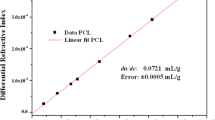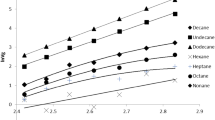Abstract
A series of commercial polyether polyols with well-defined molecular weights (MW) was used along with propylene glycol and dipropylene glycol as gel permeation chromatography (GPC) calibration standards to determine the MW and oligomeric composition of the synthesized low MW fatty acid methyl ester (FAME) polyols, having an MW of lower than 600 Da. This GPC analysis was compared to the one calibrated against the commercially-available polystyrene (PS) standards and to the number-average molecular weight (M n) obtained via vapor pressure osmometry (VPO) technique. The MW of FAME polyols obtained with GPC calibrated against polyether polyols were closer to the M n values obtained via VPO than the MW obtained via GPC calibrated against PS standards. Using the reliable GPC calibration, the MW distribution and the hydroxyl functionality of FAME polyols were determined with greater confidence.





Similar content being viewed by others
References
Li FK, Larock RC (2002) Novel polymeric materials from biological oils. J Polym Environ 10(1):59–67
Uyama H, Kuwabara M, Tsujimoto T, Kobayashi S (2003) Enzymatic synthesis and curing of biodegradable epoxide-containing polyesters from renewable resources. Biomacromolecules 4:211–215
Tsujimoto T, Uyama H, Kobayashi S (2004) Synthesis and curing behaviors of cross-linkable polynaphthols from renewable resources: preparation of artificial urushi. Macromolecules 37(5):1777–1782
Ionescu M (2005) Chemistry and technology of polyols for polyurethanes. Rapra Technology Limited, Shawbury
Guo A, Demydov D, Zhang W, Petrovic ZS (2002) Polyols and polyurethanes from hydroformylation of soybean oil. J Polym Environ 10(1):49–52
Guo A, Javni I, Petrovic ZS (2000) Rigid polyurethane foams based on soybean oil. J Appl Polym Sci 77:467
Petrovic ZS, Guo A, Javni I (2000) Process for the preparation of vegetable oil-based polyols and electroinsulating casting compounds created from vegetable oil-based polyols. US 6,107,433
Lligadas G, Ronda JC, Galià M, Biermann U, Metzger JO (2006) Synthesis and characterization of polyurethanes from epoxidized methyl oleate based polyether polyols as renewable resources. J Polym Sci 44:634–645
Chen R, Zhang C, Kessler MR (2015) Polyols and polyurethanes prepared from epoxidized soybean oil ring-opened by polyhydroxy fatty acids with varying OH numbers. J Appl Polym Sci. doi:10.1002/APP.41213
Hoong SS, Yeong SK, Abu Hassan H, Din AK, Choo YM (2015) Synthesis and characterization of polyurethanes made from copolymers of epoxidized natural oil and tetrahydrofuran. J Oleo Sci 64(1):101–115
Mohd Noor MA, Sendijarevic V, Abu Hassan H, Sendijarevic I, Tuan Ismail TNM, Hoong SS, Hanzah NA, Ghazali R (2015) Polyether polyols as GPC calibration standards for determination of molecular weight distribution of polyether polyols. J Appl Polym Sci. doi:10.1002/APP.42698
Mohd Noor MA, Sendijarevic V, Hoong SS, Sendijarevic I, Tuan Noor Maznee TI, Nurul ‘Ain H, Norhayati MN, Kosheela Devi PP, Ghazali R, Hazimah AH (2016) Molecular weight determination of palm olein polyols by gel permeation chromatography using polyether polyols calibration. J Am Oil Chem Soc 93:721–730
Fijolka P (1971) Eine methode zur quantitativen differenzierten bestimmung von primären und sekundären hydroxylendgruppen. Plaste Kautsch 18(6):431
Ling Z (2008) Structure-property relationship of polyurethane flexible foam made from natural oil polyols. Ph.D. thesis. University Of Minnesota, Minneapolis
Acknowledgements
The authors would like to express their gratitude to the Director-General of the Malaysian Palm Oil Board for the approval to publish this manuscript. The authors would like to credit Ms. Sharipah Samsiah Rahman, Mr. Makmor Abd. Wahab, Ms. Nurul ‘Ain Hanzah, Ms. Norhayati Mohd Noor, Ms. Norhidayah Ahmad Yusoff, Mr. Muhammad Ihsan Ismail and Mr. Mohamed Ahir Musa for their technical assistance in producing this article.
Author information
Authors and Affiliations
Corresponding author
About this article
Cite this article
Mohd Noor, M.A., Tuan Ismail, T.N.M., Sendijarevic, V. et al. Molecular Weight Distribution of Low Molecular Weight Polyols Derived from Fatty Acid Methyl Esters. J Am Oil Chem Soc 94, 387–395 (2017). https://doi.org/10.1007/s11746-017-2950-x
Received:
Revised:
Accepted:
Published:
Issue Date:
DOI: https://doi.org/10.1007/s11746-017-2950-x




